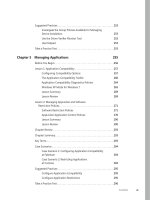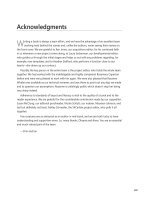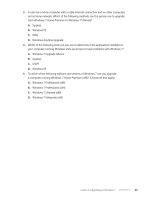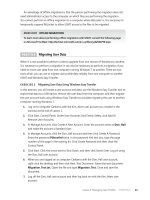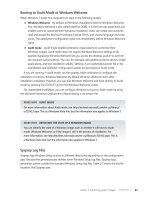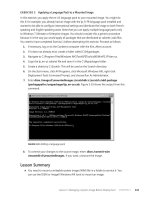Configuring Windows 7 (Training Kit) - Part 7 pptx
Bạn đang xem bản rút gọn của tài liệu. Xem và tải ngay bản đầy đủ của tài liệu tại đây (258.61 KB, 10 trang )
Lesson 2: Upgrading to Windows 7 CHAPTER 1 33
3. A user has a home computer with a cable Internet connection and no other computers
on his home network. Which of the following methods can this person use to upgrade
from Windows 7 Home Premium to Windows 7 Ultimate?
a. Sysprep
B. Windows PE
c. WDS
D. Windows Anytime Upgrade
4. Which of the following tools can you use to determine if the applications installed on
your computer running Windows Vista are known to have problems with Windows 7?
a. Windows 7 Upgrade Advisor
B. Sysprep
c. USMT
D. Windows PE
5. To which of the following editions and versions of Windows 7 can you upgrade
a computer running Windows 7 Home Premium (x86)? (Choose all that apply.)
a. Windows 7 Professional (x86)
B. Windows 7 Professional (x64)
c. Windows 7 Ultimate (x86)
D. Windows 7 Enterprise (x64)
34 CHAPTER 1 Install, Migrate, or Upgrade to Windows 7
Lesson 3: Managing User Profiles
Unless you are performing a direct upgrade from Windows Vista to Windows 7 or one that
uses roaming user profiles, any Windows 7 deployment requires that you have a plan for
moving user profile data from the user’s previous computer to the new computer. Getting
user data such as e-mail messages and Web browser bookmarks properly transferred is as
important to take into account when performing a Windows 7 deployment as getting the
right hardware platform on which to run the operating system. If you cannot get all the users’
data that was on their old computers on to their new computers, they may not be able to do
their jobs. Users also feel less intimidated by a new operating system if all their old operating
system preferences are in effect from the moment they first log on. The more comfortable
users are with a new operating system, the more favorably they will look on the transition. In
this lesson, you learn how to migrate user data from previous versions of Windows, or from
an existing installation of Windows 7, to a new installation of Windows 7.
After this lesson, you will be able to:
n
Migrate user profiles from one computer running Windows 7 to another.
n
Migrate user profiles from previous versions of Windows.
Estimated lesson time: 40 minutes
Migrating User Profile Data
User data includes more than just documents from a word processor. User data includes
things such as favorite Internet sites, customized application settings such as e-mail account
data, desktop backgrounds, files, and folders. Unless you are using roaming user profiles in
your organization, the computer that a person uses a computer is likely to have important
data stored on that computer. Migrating a user from Windows XP or Windows Vista to
Windows 7 successfully involves ensuring that all this important data makes the transition
from a person’s old computer to the new one.
You can view the list of user profiles stored on a computer running Windows 7 by opening
System within Control Panel, clicking Advanced System Settings, and then clicking the Settings
button in the User Profiles area of the Advanced System Settings tab. From this dialog box,
shown in Figure 1-17, you can view the size of user profiles, delete user profiles stored on the
computer, or change the user profile from a local profile to a roaming user profile.
A roaming user profile is a profile stored on a server that is accessible from any computer
running Windows 7 on a network. Administrators implement roaming user profiles when
people do not use a specific computer, but they might log on to any computer in the
organization. Roaming user profiles also allow central backup of user data.
Lesson 3: Managing User Profiles CHAPTER 1 35
FIGURE 1-17 A list of user profiles
Windows Easy Transfer
Windows Easy Transfer is a utility that comes with Windows 7 that you can use to transfer
user profile data from computers running Windows XP, Windows Vista, or Windows 7 to new
computers running Windows 7. As Figure 1-18 shows, Windows Easy Transfer can be used to
transfer user accounts, documents, music, pictures, e-mail, bookmarks, certificates, and other data.
FIGURE 1-18 The Windows Easy Transfer Welcome page
36 CHAPTER 1 Install, Migrate, or Upgrade to Windows 7
There are three separate methods that you can use to migrate data with Windows Easy
Transfer. The method that is appropriate depends on the circumstances of the migration. To
migrate profile data with Windows Easy Transfer, you can use any of the following:
n
Easy Transfer Cable This is a special cable with USB connectors that you can acquire
from hardware vendors. You connect one end to the source computer and the other
to the destination computer. Both computers are turned on during the migration, and
Windows Easy Transfer runs on both computers at the same time. You can perform
only a side-by-side migration using this method.
n
Network To use the network migration method, you must have two computers
running Windows Easy Transfer connected to the same local area network. Both
computers are turned on during the migration, and Windows Easy Transfer runs on
both computers at the same time. You can perform only a side-by-side migration using
this method. When performing a network migration, you configure a password on the
source computer that you have to enter on the destination computer.
n
External Hard Disk or USB Flash Drive You can specify an attached external hard disk
or USB flash drive. It is also possible to specify an internal hard disk drive or network
share when using this method. You can perform a side-by-side migration as well as
a wipe-and-restore migration using this method. You protect your data by entering
a password on the source computer that you must again enter before importing the
data on the destination computer.
Installing Windows Easy Transfer
Unless the source computer is running Windows 7, you will need to install the Windows
Easy Transfer application. This includes source computers running Windows Vista. Although
Windows Vista comes with an earlier version of the Windows Easy Transfer software, you
should use the updated Windows 7 version when transferring data to Windows 7 computers.
To install Windows Easy Transfer on the source computer, perform the following steps:
1. Run Windows Easy Transfer on the destination computer and select the transfer
method that you are going to use.
2. Select the This Is My New Computer option. If you have chosen the Easy Transfer Cable
or Network options, go to step 3. Otherwise, click No when prompted as to whether
Windows Easy Transfer has already saved your files.
3. On the Do You Need To Install Windows Easy Transfer On Your Old Computer? page,
shown in Figure 1-19, select I Need To Install It Now.
4. On the How Do You Want To Install Windows Easy Transfer On Your Old Computer?
page, select either USB Flash Drive or External Hard Disk or Shared Network Folder.
The Windows Easy Transfer application installation file will be copied to this location
and you will then be able to install the application on the source computer.
Lesson 3: Managing User Profiles CHAPTER 1 37
FIGURE 1-19 Prepare Windows Easy Transfer installation files.
Windows Easy Transfer Migration
After you have set up Windows Easy Transfer on the source computer, you are ready to
perform migration. If you want to migrate only a single user account, you can log on with
that account to perform the transfer. If you want to migrate all accounts on the computer,
you need to log on with a user account that has local administrator privileges. To do this, start
Windows Easy Transfer, select the transfer method, and then, on the Which Computer Are
You Using Now? page, select This Is My Old Computer. If you are using the External Hard Disk
or USB storage device method, Windows Easy Transfer will then perform a migration check
and provide an estimate of the size of the data you can transfer to the new computer on the
source computer. If you are using the Network or Easy Transfer Cable method, you will select
items for migration on the destination computer.
When selecting items for migration, you can accept the default values or customize
what to migrate for each user account and all shared items. To customize, click Customize
under each user account. This will allow you to select whether you want to transfer each
user’s Documents, Music, Pictures, Videos, Program Settings, Windows Settings, and Other
Items. If you want to be more specific, you can click Advanced, which brings up the Modify
Your Selections dialog box shown in Figure 1-20. This dialog box allows you to select which
accounts to migrate, as well as which files and folders Windows Easy Transfer will migrate to
the new machine.
By selecting Advanced, you can determine what you want to do with the user accounts
being migrated from the source computer to the destination computer. You have the option of
mapping a user account on the old computer to a specific user account on the new computer or
38 CHAPTER 1 Install, Migrate, or Upgrade to Windows 7
FIGURE 1-20 Customizing data transferred by Windows Easy Transfer
you can have Windows Easy Transfer create a new account as shown in Figure 1-21. If you select
the Create A New Account option, you will need to specify a password for the new account. If
you do not choose to use Advanced, Windows Easy Transfer will create new accounts on the
computer running Windows 7 with the old account names but will assign a blank password that
needs to be changed when the user associated with that account first tries to log on.
FIGURE 1-21 Transferring accounts using Windows Easy Transfer
Lesson 3: Managing User Profiles CHAPTER 1 39
The first step to take when running Windows Easy Transfer on the destination computer is
to specify the transfer method that you are going to use and that this is your new computer.
Depending on which method you are using, one of the following will happen:
n
If you are using the external hard disk or USB flash drive method, you will be asked to
specify the location of the Easy Transfer file and to enter a password to open it.
n
If you are using the network method, you will need to enter the Windows Easy Transfer
key before the transfer will begin. The source computer displays this key. You will then
go through the process of selecting what to transfer that was described previously.
n
If you are using the Easy Transfer Cable method, the wizard will attempt to detect
the cable and then will initiate the transfer. You will then go through the process of
selecting what to transfer as described earlier.
You will use Windows Easy Transfer to perform a migration in the practice exercise at the
end of the lesson.
Quick Check
n
Which Windows Easy Transfer method should you use when you want to perform
a wipe-and-load migration?
Quick Check Answer
n
The only Windows Easy Transfer method that supports wipe-and-load migrations
is the External Hard Disk or USB flash drive method.
User State Migration Tool
USMT 4.0 is a command-line utility that allows you to automate the process of user profile
migration. The USMT is part of the Windows Automated Installation Kit (WAIK) and is a
better tool for performing a large number of profile migrations than Windows Easy Transfer.
The USMT can write data to a removable USB storage device or a network share but cannot
perform a direct side-by-side migration over the network from the source to the destination
computer. The USMT does not support user profile migration using the Windows Easy Transfer
cable. USMT migration occurs in two phases, exporting profile data from the source computer
using ScanState and importing profile data on the destination computer using LoadState.
USMT 4.0 allows you to capture user accounts, user files, and operating system and
application settings. The USMT tool also migrates access control lists (ACLs) for files and
folders, ensuring that permissions set on the source computer are retained on the destination
computer. You can use USMT to migrate profile data to computers running Windows 7 from
computers running Windows XP, Windows Vista, and Windows 7. You can also use the USMT
to migrate data from computers running Windows 7 to Windows Vista. You cannot use USMT
to migrate mapped network drives, local printers, device drivers, passwords, shared folder
permissions, and Internet connection sharing settings.
40 CHAPTER 1 Install, Migrate, or Upgrade to Windows 7
note USMT AND DOWNGRADES
You cannot use the USMT to migrate data from computers running Windows 7 to
computers running Windows XP.
Unlike Windows Easy Transfer, where you select the particular items you want to migrate
when you are running the application, with USMT, you configure a set of migration rules prior
to the migration that specify what data to export from the source computer.
There are four different .xml migration files used with the USMT:
n
MigApp.xml This file contains rules about migrating application settings. These
include Accessibility settings, dial-up connections, favorites, folder options, fonts,
group membership, Open Database Connectivity (ODBC) settings, Microsoft Office
Outlook Express mailbox files, mouse and keyboard settings, phone and modem
options, Remote Access Service (RAS) connection phone book files, regional options,
remote access, screen-saver settings, taskbar settings, and wallpaper settings.
More Info MIGRATING CUSTOM APPLICATIONS
You cannot migrate the settings of some custom applications using MigApp.xml. In
this case, you need to create a custom migration Extensible Markup Language (XML)
file. To learn more about creating custom application migration XML files, consult the
following Microsoft TechNet reference: />dd560773(WS.10).aspx.
n
MigUser.xml This file contains rules about user profiles and user data. The default
settings for this file migrate all data in My Documents, My Video, My Music,
My Pictures, desktop files, Start Menu, Quick Launch settings, favorites, Shared
Documents, Shared Video, Shared Music, Shared desktop files, Shared Pictures, Shared
Start menu, and Shared Favorites. This file also contains rules that ensure that all the
following file types are migrated from fixed volumes: .qdf, .qsd, .qel, .qph, .doc, .dot,
.rtf, .mcw, .wps, .scd, .wri, .wpd, .xl*, .csv, .iqy, .dqy, .oqy, .rqy, .wk*, .wq1, .slk, .dif, .ppt*,
.pps*, .pot*, .sh3, .ch3, .pre, .ppa, .txt, .pst, .one*, .mpp, .vsd, .vl*, .or6, .accdb, .mdb, .pub,
.xla, .xlb and .xls. The asterisk (*) represents zero or more characters.
n
MigDocs.xml This file contains information on the location of user documents.
n
Config.xml This file is different from the other migration files as it is used to exclude
features from the migration. You can create and modify the Config.xml file using
ScanState.exe with the /genconfig option.
It is also possible to create custom XML files to be used with the migration. For example,
you can create a custom XML file that reroutes folders, specific file types, or specific files. You
would use rerouting if you wanted to move all the files of one type, such as .avi files, that
may have been stored in different places on the source computer to a specific folder on the
destination computer.
Lesson 3: Managing User Profiles CHAPTER 1 41
More Info REROUTING FILES AND SETTINGS
To learn more about rerouting files and settings using USMT, consult the following Web
page on Microsoft TechNet: />ScanState
You run ScanState on the source computer during the migration. You must run ScanState.
exe on computers running Windows Vista and Windows 7 from an administrative command
prompt. When running ScanState on a source computer that has Windows XP installed, you
need to run it as a user that is a member of the local administrators group.
The following command creates an encrypted store named Mystore on the file share
named Migration on the file server named Fileserver that uses the encryption key Mykey:
scanstate \\fileserver\migration\mystore /i:migapp.xml /i:miguser.xml /o /config:config.xml
/encrypt /key:"mykey"
Running ScanState and LoadState with the /v:13 option creates a detailed log file. You
should use this option if you are having problems migrating data.
More Info SCANSTATE
To learn more about the specifics of ScanState syntax, consult the following Microsoft
TechNet Web page: />LoadState
LoadState is run on the destination computer. You should install all applications that were on
the source computer on the destination before you run LoadState. You must run Loadstate.
exe on computers running Windows Vista and Windows 7 from an administrative command
prompt.
To load profile data from an encrypted store named Mystore that is stored on a share
named Migration on a file server named Fileserver and which is encrypted with the
encryption key Mykey, use this command:
loadstate \\fileserver\migration\mystore /i:migapp.xml /i:miguser.xml /decrypt
/key:"mykey"
More Info LOADSTATE
To learn more about the specifics of LoadState syntax, consult the following Microsoft
TechNet Web page: /> 42 CHAPTER 1 Install, Migrate, or Upgrade to Windows 7
Migration Store Types
When planning a migration using USMT, you need to decide where you are going to store
migrated data that is generated by ScanState on the source computer and required by
LoadState on the destination computer. USMT supports three types of migration stores:
n
Uncompressed Uncompressed migration stores use a hierarchy of folders that mirror
the user profile data being migrated. You can navigate an uncompressed migration
store using Windows Explorer. This creates a duplicate of the backed-up files in
another location.
n
Compressed A compressed migration store is a single image file that contains all data
being migrated. The image file can be encrypted and password-protected. It is not
possible to navigate to this file using Windows Explorer.
n
Hard-link Hard-link migration stores are used in wipe-and-load scenarios only. The
hard-link migration store is stored on the local computer while the old operating
system is removed and the new operating system is installed. Use the /hardlink option
with ScanState to create a hard-link migration store. Hard linking does not create a
duplicate of the migrated data and hence uses less space than the uncompressed or
compressed stores when those are used on the volume being migrated. Hard-link
migrations require only 250 MB of free space on the volume being migrated,
regardless of the amount of profile data being migrated.
ScanState with the /p option allows you to estimate the size of the migration store prior
to performing a migration. All migrations require a minimum of 250 MB of free space on the
volume being migrated.
More Info MIGRATION STORE TYPES
To learn more about USMT migration store types, consult the following article on
Microsoft TechNet: />Performing Offline Migrations
You can use USMT to perform offline migrations. Offline migrations involve booting the
computer into a Windows PE environment that includes the USMT files and then running
ScanState against the installation of Windows on the computer’s hard disk drive. You must still
run the LoadState feature of the migration from within Windows 7. You cannot run LoadState
when booted into a Windows PE environment.
note SCANSTATE AND UPGRADES
You can also run ScanState in offline mode against the Windows.old directory that is
generated when you perform an upgrade from Windows Vista.

